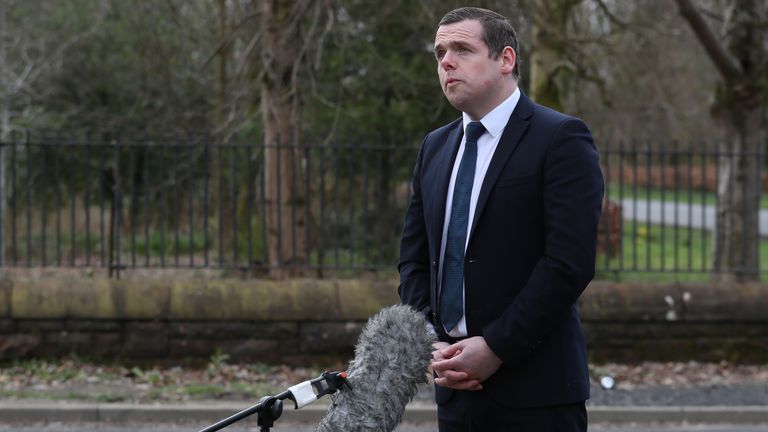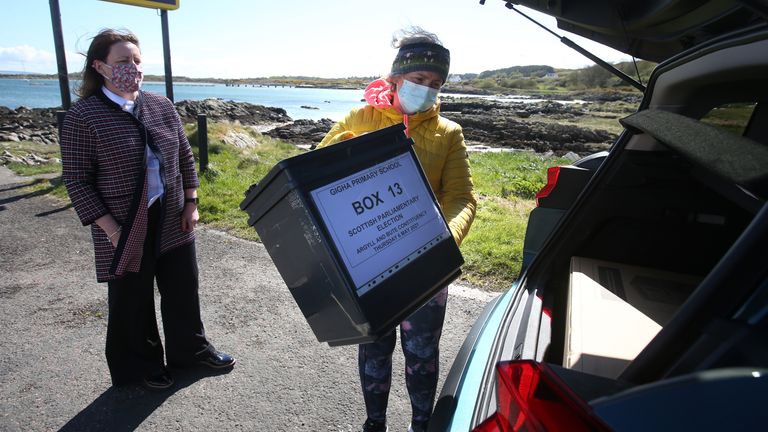
Vote 2021: Five things to look out for in the Scottish election results
This year’s Scottish election is high-profile and has far-reaching consequences for the future of the UK.
But, COVID-safe counting means we will not get the Holyrood results as fast as normal.
Instead, they will be announced slowly throughout Friday and Saturday. We may not have the final tallies before Saturday evening or even Sunday morning, but the trends should be clear far sooner.
Scots have two votes: one for their constituency, and a second for the region they live in known as “the list”. The latter is intended to make the system more proportional and allows smaller parties to boost their number of seats.
Because the SNP are likely to be so successful in constituencies, they will not pick up many seats on the list. This is because in calculating the distribution of regional seats, the success of a party in constituencies is taken into account.
Here are five things to look for as the counts commence:
1) Will the SNP secure a majority?
Nicola Sturgeon’s position as First Minister is not in doubt. Neither is the SNP’s place as the largest party in the Scottish Parliament.
Instead, the focus is now on whether the nationalists get a majority of seats – at least 65 of the 129 on offer.
Ms Sturgeon argues if she wins a majority of MSPs in the Scottish Parliament, she will have a mandate for a second referendum on Scottish independence. At the last election in 2016, the SNP won 63 seats, two short of a majority.
Under Scotland’s proportional electoral system of constituency MSPs and regional MSPs, the easiest path to an SNP majority is by gaining more constituency seats.
Keep an eye on Edinburgh Central where the party’s former Westminster leader Angus Robertson is hoping to beat the Conservatives.
The incumbent is ex-Scottish Tory leader Ruth Davidson who is standing down to take a seat in the House of Lords. Mr Robertson needs just a 1% swing from the Conservatives to win.
Aside from securing gains, the SNP will also need to stem losses, including Perthshire North where Deputy First Minister John Swinney is fighting off a challenge from long-time Tory rival Murdo Fraser. The Scottish Conservatives need a 5% swing for victory.
2) Who will come second?
At the last Scottish elections in 2016, the Conservatives scored a historic coup by beating Labour to second place. Once the establishment party of Scotland, Scottish Labour’s disastrous performance came a year after they lost 40 of their 41 MPs in the 2015 general election.
The Tory pitch in 2016 – to be a “strong opposition” to the SNP – proved successful. But can they keep it that way?
Both parties oppose independence and now have new, young leaders: 38-year-old Douglas Ross has been leading the Scottish Conservatives for nine months. Scottish Labour’s Anas Sarwar is the same age but has been in post for just 10 weeks.
Sir Keir Starmer knows a Labour revival north of the border is vital if he is ever to become prime minister.
It is worth watching Dumbarton where Scottish Labour veteran Jackie Baillie is defending a wafer-thin majority of 109 votes. She will be hoping her prominent performance questioning Alex Salmond and Nicola Sturgeon during their evidence at Holyrood’s harassment committee will have raised her profile.
Ms Baillie’s main challenger is SNP candidate and Come Dine With Me contestant Toni Giugliano (as an Italian Scot, he served haggis pasta and won).
3) How far will the Greens surge?
The Scottish Greens back independence, work closely with the SNP, and are already part of a pro-indy majority at Holyrood.
Some polls suggest they may be able to double their number of MSPs after securing six in 2016.
All of these will likely be regional (or list) seats, suggesting the party may benefit from SNP-backers voting tactically with their second ballot paper.
A renewed focus on climate change policy may also have bolstered their support.
The party has come a long way since the first Holyrood elections in 1999, when a single Green MSP was elected, becoming the UK’s first green parliamentarian.
4) Will Alex Salmond succeed?
Nicola Sturgeon’s mentor turned rival Alex Salmond launched a new political party in March.
After running the SNP for 20 years, leading Scotland for seven, taking the country to the brink of independence and then falling out with his successor, Mr Salmond launched the Alba Party.
Named after the Scottish Gaelic word for Scotland, Alba has tried to encourage SNP supporters to lend them their second votes.
Mr Salmond argued this would mean more pro-independence MSPs elected, and a “super-majority” for Scotland leaving the UK.
Some polls suggest Alba may get two or three MSPs at best, and Mr Salmond may not be one of them.
If he does secure a seat, Mr Salmond may cause problems in parliament for Ms Sturgeon and put pressure on her to pursue a more radical path to separation.
5) How will Boris Johnson respond?
Whatever the results – and especially if the SNP win a majority – the tone of Mr Johnson’s response will be important and fascinating.
If Ms Sturgeon gets more than 65 MSPs, a showdown between the first minister and prime minister is inevitable.
The Scottish government needs permission from Westminster to hold an independence referendum, but Mr Johnson has consistently opposed another vote and the Scottish Conservatives have campaigned on a platform of blocking one.
Theresa May’s line from 2017 that “now is not the time” may be resurrected. Mr Johnson is also likely to cite the economic recovery post-COVID as another justification.
Ms Sturgeon has said she would like to hold a referendum in the first half of the next Scottish parliamentary term.
Source: Read Full Article






